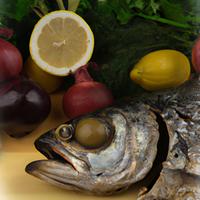
1 serving (100 grams) contains 150 calories, 20.0 grams of protein, 8.0 grams of fat, and 0.0 grams of carbohydrates.

Log this food in SnapCalorie

Nutrition Information
Calories |
357.1 | ||
|---|---|---|---|
% Daily Value* |
|||
| Total Fat | 19.0 g | 24% | |
| Saturated Fat | 4.8 g | 24% | |
| Polyunsaturated Fat | 0 g | ||
| Cholesterol | 166.7 mg | 55% | |
| Sodium | 166.7 mg | 7% | |
| Total Carbohydrates | 0 g | 0% | |
| Dietary Fiber | 0 g | 0% | |
| Sugars | 0 g | ||
| protein | 47.6 g | 95% | |
| Vitamin D | 476.2 mcg | 2381% | |
| Calcium | 71.4 mg | 5% | |
| Iron | 2.4 mg | 13% | |
| Potassium | 714.3 mg | 15% | |
* Percent Daily Values are based on a 2,000 calorie diet. Your daily values may be higher or lower depending on your calorie needs.
Food Attributes
Source of Calories
About Head of fish
The head of fish is a nutrient-rich component often emphasized in various global cuisines, especially Asian and African culinary traditions. Packed with Omega-3 fatty acids, collagen, and essential vitamins such as Vitamin D and B12, fish heads offer significant health benefits, promoting brain function, heart health, and skin elasticity. The gelatinous texture and concentrated flavor make them ideal for soups, curries, and stews, contributing depth and richness to dishes. Minerals like calcium, phosphorus, and iodine found in their bones and cartilage further enhance their nutritional profile. However, as they can occasionally contain higher mercury levels depending on the fish species, moderation is advised, especially for pregnant women and children. Widely regarded as a sustainable eating practice, utilizing the fish head reduces waste and showcases the value of whole-animal cooking.



